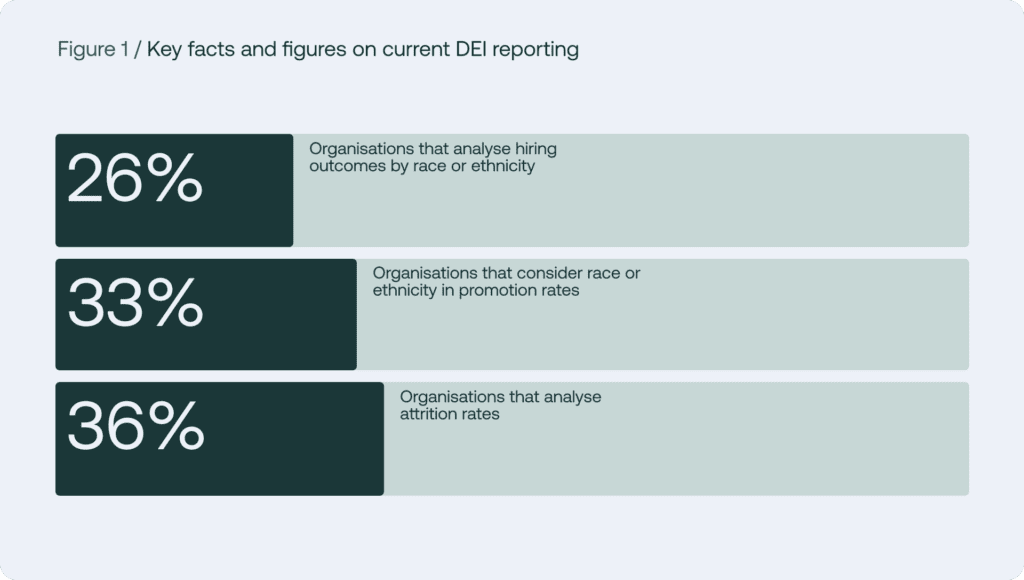 Behind the scenes of Nexio Projects’ annual EcoVadis assessment: Lessons, growth and commitment
Behind the scenes of Nexio Projects’ annual EcoVadis assessment: Lessons, growth and commitment
Transparency is essential in today’s corporate landscape, especially for Diversity, Equity, and Inclusion (DEI) reporting. This article outlines steps to enhance your DEI reporting strategy, ensuring it aligns with regulatory requirements and stakeholder expectations. For a deeper dive into the topic, download our free comprehensive guide.

A new era of DEI transparency
Trust is fundamental to creating a thriving corporate culture and building a positive reputation.
In an era where transparency and social consciousness are highly valued, organisations must prioritise comprehensive DEI reporting.
New laws, such as the EU’s Corporate Sustainability Reporting Directive (CSRD), now mandate companies to report on social issues. These issues include working conditions, employment practices, and diversity in the workplace.
Additionally, the Global Reporting Initiative (GRI) has included human rights information in its disclosures.
Companies are now under pressure to back their DEI strategies with comprehensive, verifiable, and comparable data. Currently (based on a US study):
- only 26% of organisations analyse hiring outcomes by race or ethnicity;
- 33% consider these factors in promotion rates;
- only 36% analyse attrition rates by race or ethnicity.

Trends in DEI reporting
Global trends in DEI reporting emphasise standardising metrics through frameworks like GRI and SASB, increasing regulatory requirements, and enhancing transparency and accountability.
Companies are focusing on intersectionality, leveraging technology for analytics, and integrating DEI goals into business strategies.
Key trends also include employee engagement, balancing global and local approaches, longitudinal reporting, and broad stakeholder engagement.
Strengthening your DEI reporting
Organisations should establish a systematic reporting framework that reflects their DEI maturity level to effectively communicate their efforts.
Follow the steps below to build a solid foundation for more effective DEI reporting. This will help to drive meaningful change and promote a more inclusive environment.

Step 01 / Define your reporting scope and objectives
- Identify specific DEI areas relevant to your organization, such as gender equality, racial diversity, or inclusive workplace practices.
- Decide which demographic groups to include in your report, such as gender, age, race, disability, and LGBTQ+ status.
- Create a core group within the organization to define DEI objectives, making sure to reflect various perspectives.
Step 02 / Collect and analyze data
- Implement secure data collection methods to ensure privacy and accuracy.
- Analyze the data to identify trends, gaps, and areas for improvement, enabling benchmarking and progress measurement.
Step 03 / Communicate findings and take action
- Transparently share insights with stakeholders through visuals and reports.
- Develop and implement action plans based on findings to address DEI gaps and promote inclusivity.
- Regularly review and update these plans to ensure accountability.
Compliant or leading: The next steps on your DEI journey
Knowing what to focus on for your DEI reporting depends on your material topics and goals for the report.
Organizations find themselves at different points along the sustainability maturity curve. For the sake of comprehension, this article simplifies the approach on two levels: compliance and best practice.
Compliant
This level focuses on meeting minimum regulatory requirements. Examples include:
- Implementing a zero-tolerance policy for discrimination and harassment.
- Conducting regular pay equity audits.
- Providing mandatory diversity and inclusion training.
- Establishing formal processes for reporting DEI-related complaints.
Leading
Leading organisations demonstrate a proactive commitment to DEI initiatives. Examples include:
- Linking executive compensation to DEI goals.
- Implementing blind resume screening to reduce hiring bias.
- Empowering a Chief Diversity Officer with a dedicated team.
- Supporting employee resource groups (ERGs).
- Conducting regular anonymous surveys and focus groups for feedback.
- Showcasing DEI commitments through external communications.
Tips for preparing a leading DEI report
Define your DEI scope and objectives
- Consider which elements of diversity, equity, and inclusion are relevant. Track metrics such as age diversity, pay equity, and employee engagement.
- Align with best practice frameworks like GRI standards and comply with regional regulations.
Get clarity on your material topics
- Focus on specific metrics relevant to your organisation to avoid poor-quality data.
- Measure and report on targeted areas to produce a representative DEI report.
Share personal stories to make an impact
Include interviews or case studies to provide context and highlight the impact of your DEI initiatives.
Follow best practice frameworks
Adhere to recognized standards like GRI and regulations such as the CSRD in the EU.
Taking your DEI reporting to the next level
Regardless of your organization’s DEI maturity level, take steps to strengthen your reporting strategy. Align these steps with your organisation’s strategy:
- Ensure consistency by creating standardised data collection templates.
- Start at a manageable scale.
- Use available software tools.
- Build a trusted team to support DEI objectives.
DEI reporting is not just about compliance; it’s about fostering a culture of inclusion and accountability. By implementing these strategies, organisations can drive meaningful change and create a more diverse and equitable workplace.
For further insights, explore the full guide.












